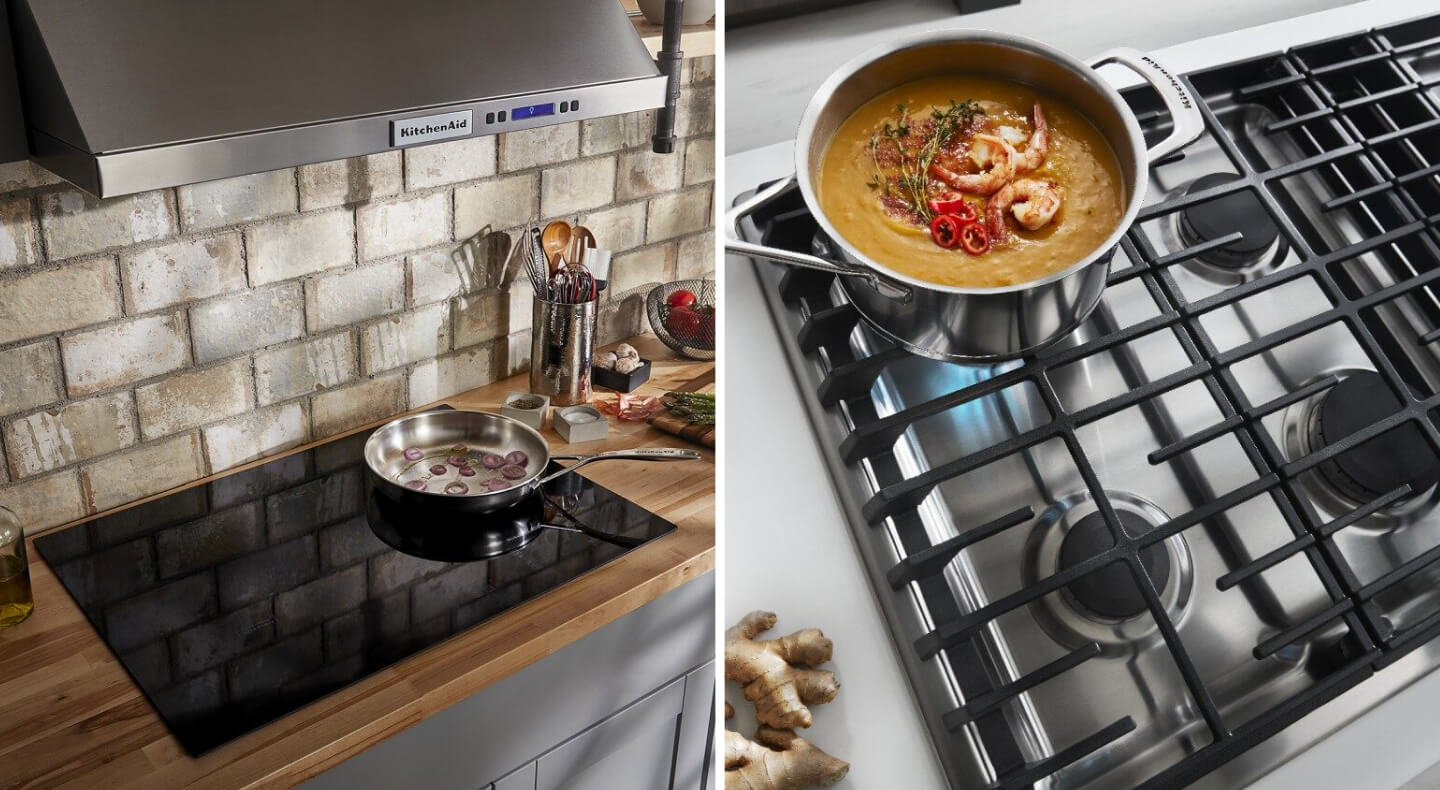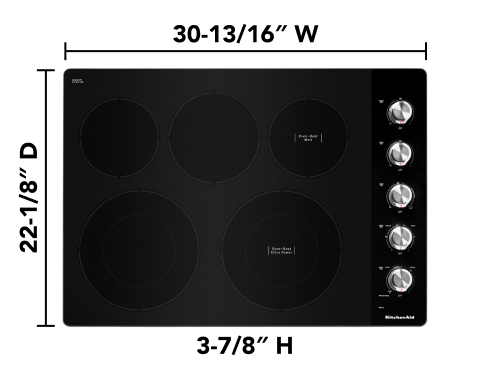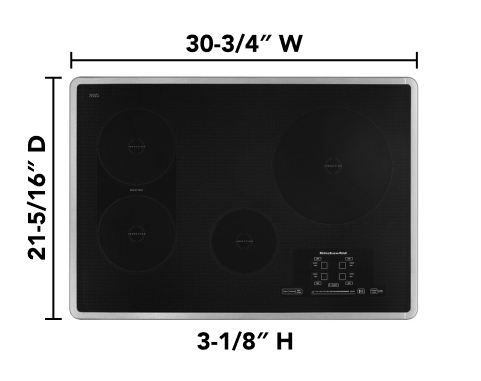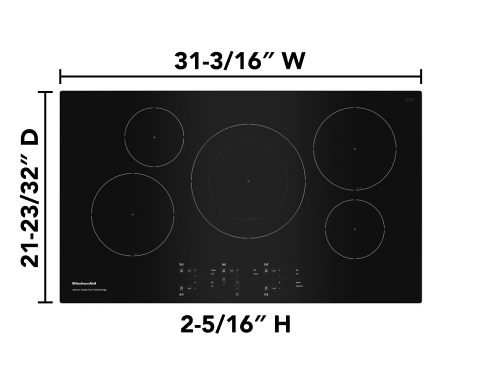
Cooktop sizes: Gas, electric and induction
Purchasing a new cooktop is an exciting opportunity to add functionality and style to your home. Versatile tools for any kitchen, cooktops come in several sizes and types (gas, electric, induction and downdraft) to fit your needs while featuring innovative designs. With so many options, this guide will help you narrow them down to help find the perfect fit for your kitchen and culinary interests.


What is a standard cooktop size?
A standard size cooktop is typically between 30 and 36 inches wide. Some models may also come in a variety of sizes, such as 15 to 24 inches, 45 inches and 48 inches. Standard cooktops can come in a variety of configurations with four or five burners, different BTU levels and unique features.
KitchenAid brand offers a wide variety of cooktop types and sizes to match your space and express your passion, including gas, electric, induction and downdraft models.
Shop popular standard size cooktops from KitchenAid brand
Because no two kitchens are the same, KitchenAid® cooktops come in a variety of standard sizes to help you find the perfect placement. Select KitchenAid® models with Five Cooking Zones let you cook with up to five pans at once, empowering a variety of cooking adventures. Three round elements in 10", 7" and 6" sizes fit stock pots, saucepans and skillets. The KitchenAid® Even-Heat™ Zone can be used as one large element or two separate elements, adding versatility for griddles or two pans at once.


What size cooktop do I need?
Cooktop dimensions will vary depending on the size of your kitchen and the way you like to create. Typically, cooktop sizes range from 15 to 36 inches wide to accommodate small-space apartments and large kitchens alike.
Looking for more space to create? Commercial-sized cooktops can range from 30 to 48 inches wide, and sometimes larger.
Shop KitchenAid® cooktops in every size
Whether you need a cooktop that will fit a smaller kitchen footprint or you’re looking for a powerful commercial-style gas cooktop, KitchenAid brand has a variety of models for you to choose from. To start your search, consider standard KitchenAid® 30- and 36-inch gas cooktops or 30- and 36-inch electric cooktops.
How to measure a cooktop
Determining your cooktop dimensions can be accomplished in a few simple steps, and all you need is a tape measure. For the most accurate results, be sure to measure both the cooktop surface itself and the appliance cutout.
Be mindful that the size of your cooktop may differ from the size of your appliance cutout. Typically, cutout dimensions are smaller than cooktop dimensions because it allows the appliance surface to extend beyond the cutout space and align with your countertops.

1. Measure cooktop width
Simply run a tape measure from the right outer edge to the left outer edge of the cooktop surface.

2. Measure cooktop depth
Using the same technique as step 1, measure from the front to the back of the cooktop, including the control panel.

3. Measure the appliance cutout width
Similar to measuring the cooktop width, run the measuring tape from the right edge to the left edge of the cutout space.
For increased accuracy, record one measurement from the front of the cutout and one from the back of it.

4. Measure the appliance cutout depth
Similar to measuring the cooktop depth, simply measure the cutout from front to back.
For increased accuracy, record one measurement from the left side of the cutout and one from the right side.
Measurement tip
If there are discrepancies between the width or depth dimensions of your cutout space after your measurements, always utilize the smallest dimension for each. This helps ensure a more accurate fit for your cooktop.
Shop KitchenAid® induction cooktops
KitchenAid® induction cooktops give you the responsiveness and control you need to help you cook with passion. Equipped with Temp Cook™ Induction Technology, select KitchenAid® induction models let you set an exact temperature from 120 to 400 degrees, for precise control beyond standard high, medium and low settings. Dual sensors in the cooktop help keep your pan from overheating, so you can take on ambitious recipes with delicious results, batch after batch.


Gas vs. electric cooktop sizes
Electric and gas cooktops have different power sources, but they usually come in the same sizes. A standard cooktop is often between 30 to 36 inches wide and can feature four or five burners for added flexibility to take on all of your culinary creations. KitchenAid brand offers a variety of gas cooktops and electric cooktops to fit your personal cooking style and creative space.
If you’re looking for a cooktop that heats up quickly and is easy to clean thanks to its smooth glass top surface, explore induction cooktops by KitchenAid brand.
Shop KitchenAid® gas cooktops
Whether you need to simmer, steam, grill or boil, KitchenAid® gas cooktops will ignite your imagination. With a variety of features to choose from—such as griddles and burners—as well as a countertop design that makes them easy to install nearly anywhere in your kitchen, these cooktops are a great fit for both your kitchen and your cooking.
Shop KitchenAid® electric cooktops
Electric cooktops provide the flexibility and capacity to power your culinary capabilities.
Select KitchenAid® models offer 10''/6'' Even-Heat™ Ultra Power™ Element with Simmer Setting, which adds versatility for high and low temperature cooking. Even-Heat™ Technology delivers constant power and a range of simmer settings. Two element sizes in one make it ideal for boiling, yet also accept small pans for various cooking tasks.


Features to look for in a cooktop
There are a number of considerations to keep in mind when looking for a new cooktop.
Number of burners: If you find yourself creating a variety of dishes all at once, you may want a cooktop with five or six burners rather than four.
Fuel source: Identify what fuel source works best for your home and whether you are cooking enough to require a commercial-style upgrade.
Cooking features: Will having convertible grates, dual or triple elements or multiple griddle options expand your cooking abilities? Convertible grates allow you to customize your burners for a range of techniques and can make room for sculpted cookware like woks.
Aesthetics: Think about which color option best fits your kitchen palette and what design options complement your current setup.
Cooktop surface: Some cooktop surfaces, such as ceramic or glass surfaces on electric cooktops, are considered among the easiest cooktop surfaces to clean.
Ventilation options: Adequate ventilation can help reduce smoke, grease and odors in the kitchen. Consider downdraft cooktops that integrate ventilation directly into the cooktop surface, eliminating the need for overhead options.
Smart technology: Some cooktops may come with convenient smart features that can help you unlock more potential in the kitchen. Select KitchenAid® induction cooktops offer Temp Cook™ Smart Presets that automate ideal cooking temperatures for popular cooking methods.
Installation: Each cooktop has its own unique installation needs you should take into account. Consider dedicated fuel lines for gas cooktops, the size of your cutout or whether you intend to install your cooktop on your kitchen island.
Energy efficiency: If you’re looking for a cooktop that helps you create more efficiently, consider induction cooktops. Little to no heat is generally lost between the cooktop surface and your food when using an induction cooktop due to the electromagnetic energy that heats cookware directly.
- Warranties: Warranties can provide you with peace of mind by potentially covering repairs needed for your appliance. They may vary depending on appliance type, brand and model, so always check the appliance’s warranty details.
Explore KitchenAid® cooktops
With a variety of fuel types and configurations to choose from, KitchenAid® cooktops offer the features you need to sear, simmer, sauté and more. Browse KitchenAid® gas, electric, induction and downdraft models to find the one that’s ideal for how you create.
When shopping for a kitchen cooktop, it is key to consider the number of burners, features and overall size of the unit for your creative space, including island ranges or cooktops.
If flexibility is your priority, a KitchenAid® five-burner or six-burner cooktop may be ideal. There are a wide variety of convenient features to help expand your creative possibilities and heighten culinary cooktop experiences in the kitchen.












